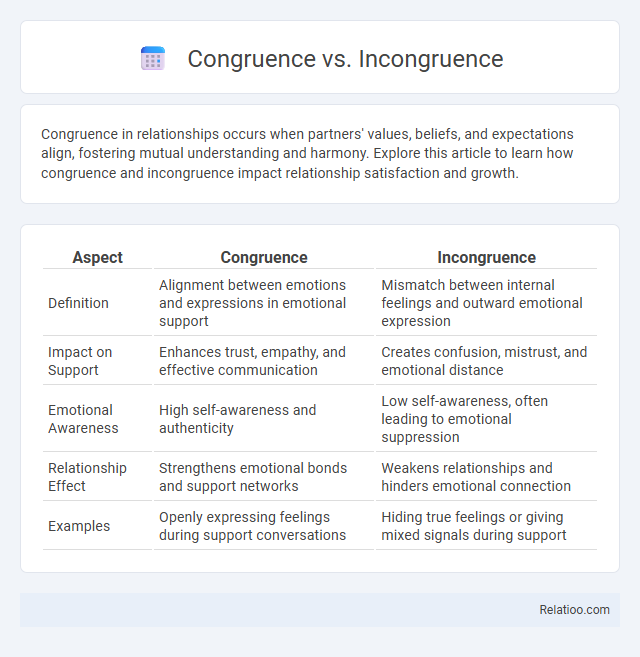Congruence in relationships occurs when partners' values, beliefs, and expectations align, fostering mutual understanding and harmony. Explore this article to learn how congruence and incongruence impact relationship satisfaction and growth.
Table of Comparison
| Aspect | Congruence | Incongruence |
|---|---|---|
| Definition | Alignment between emotions and expressions in emotional support | Mismatch between internal feelings and outward emotional expression |
| Impact on Support | Enhances trust, empathy, and effective communication | Creates confusion, mistrust, and emotional distance |
| Emotional Awareness | High self-awareness and authenticity | Low self-awareness, often leading to emotional suppression |
| Relationship Effect | Strengthens emotional bonds and support networks | Weakens relationships and hinders emotional connection |
| Examples | Openly expressing feelings during support conversations | Hiding true feelings or giving mixed signals during support |
Understanding Congruence: A Brief Overview
Understanding congruence involves recognizing the alignment between thoughts, feelings, and actions, which fosters authenticity and psychological well-being. Incongruence occurs when there is a disconnect between one's internal experiences and external behavior, often leading to stress and confusion. Congruence in communication and relationships enhances trust, clarity, and emotional harmony by ensuring consistency and genuine expression.
Defining Incongruence in Psychology
In psychology, incongruence refers to a mismatch between an individual's self-perception and their actual experiences or behaviors, often leading to internal conflict and decreased psychological well-being. Unlike congruence, where self-image and experiences align harmoniously, incongruence creates tension that can affect emotional health and personal growth. Understanding this concept can help you identify areas in your life where self-awareness and acceptance can improve overall mental resilience.
Core Differences: Congruence vs Incongruence
Congruence refers to the alignment between a person's internal beliefs, values, and external behaviors, leading to authentic and consistent actions. Incongruence occurs when there is a mismatch between internal experiences and outward expressions, often resulting in psychological stress or confusion. The core difference lies in congruence fostering harmony and self-consistency, while incongruence generates internal conflict and distress.
The Role of Self-Concept in Congruence
Self-concept plays a pivotal role in congruence by aligning an individual's perceptions with their experiences, fostering psychological well-being and authentic behavior. Incongruence arises when there is a mismatch between self-concept and experiences, often leading to inner conflict, stress, and diminished self-esteem. Achieving congruence through self-concept clarity supports cognitive consistency and emotional stability, essential for personal growth and resilience.
Causes and Origins of Incongruence
Incongruence stems from a mismatch between your self-perception and external experiences, often caused by conflicting values, unmet expectations, or social pressures. Origins of incongruence include childhood conditioning, trauma, and adaptive behaviors developed to gain acceptance or avoid rejection. Understanding these causes helps identify areas for personal growth and improving psychological harmony.
Effects of Congruence on Mental Health
Congruence, defined as the alignment between an individual's self-perception and experiences, significantly enhances mental health by fostering self-acceptance and reducing internal conflict. Incongruence, characterized by a mismatch between self-concept and reality or external feedback, often leads to increased anxiety, depression, and psychological distress. Maintaining congruence promotes emotional well-being, resilience, and authentic social interactions, making it a critical factor in positive mental health outcomes.
How Incongruence Impacts Relationships
Incongruence in relationships occurs when there is a mismatch between partners' values, expectations, or communication styles, leading to misunderstandings and emotional distance. This misalignment often causes increased conflict, reduced trust, and diminished intimacy, undermining relationship satisfaction. Addressing incongruence through open dialogue and empathy enhances mutual understanding and strengthens relational bonds.
Achieving Congruence: Practical Strategies
Achieving congruence involves aligning personal values, beliefs, and behaviors to foster authenticity and psychological well-being. Practical strategies include reflective practices such as journaling, seeking feedback from trusted sources, and setting clear, consistent goals that mirror core values. Maintaining congruence promotes improved communication, reduced internal conflict, and enhanced decision-making in both personal and professional contexts.
Real-Life Examples: Congruence and Incongruence
Congruence occurs when an individual's actions, values, and beliefs are aligned, such as a teacher who genuinely practices the ethical standards they preach, fostering trust and authenticity in the classroom. Incongruence is evident when there is a mismatch between one's expressed attitudes and actual behavior, like a manager advocating for transparency yet withholding critical information from employees. Real-life examples highlight the impact of congruence on effective communication and relationship-building, while incongruence often leads to misunderstandings and decreased credibility.
Congruence and Incongruence in Therapy Sessions
Congruence in therapy sessions refers to the therapist's genuine, authentic presence and alignment between their internal feelings and external expressions, fostering trust and openness with clients. Incongruence occurs when there is a mismatch between the therapist's verbal communication and nonverbal cues, potentially causing confusion and hindering the therapeutic alliance. Maintaining congruence is essential for effective therapy, as it promotes client safety, emotional connection, and meaningful progress in treatment outcomes.

Infographic: Congruence vs Incongruence
 relatioo.com
relatioo.com